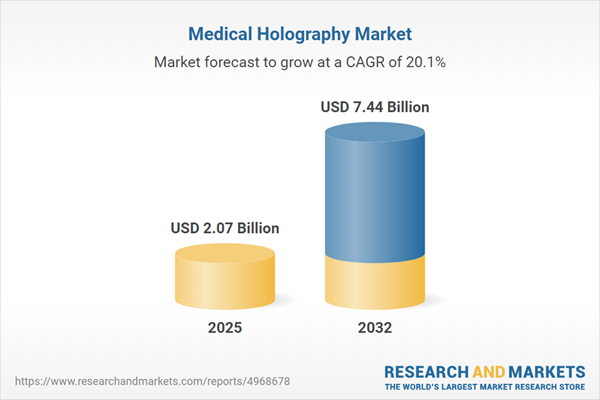Speak directly to the analyst to clarify any post sales queries you may have.
Medical holography is transforming digital healthcare, equipping organizations with precise visualization tools that accelerate clinical excellence and operational efficiency. For senior leaders guiding digital transformation, this technology enables sustainable, scalable modernization while supporting robust cross-functional collaboration.
Market Snapshot: Medical Holography Market Growth
The global medical holography market is expanding rapidly, supported by growing demand for advanced three-dimensional visualization and digital imaging. Valued at USD 1.72 billion in 2024, the market is forecasted to reach USD 2.07 billion in 2025 and is anticipated to achieve USD 7.44 billion by 2032, representing a compound annual growth rate (CAGR) of 20.09%. This accelerated growth is fueled by the need for more refined diagnostics, higher patient engagement, and improvements in the clinical workflow. Adoption is increasing across hospitals, research institutions, and technology organizations worldwide, with both developed and emerging regions integrating standardized holography solutions as key aspects of digital health strategies. Senior executives are positioning medical holography as a cornerstone for healthcare modernization and innovation leadership.
Scope & Segmentation: Medical Holography Strategic Overview
Identifying and addressing critical market segments in medical holography is essential for senior leaders planning resource allocation, investment, and innovation priorities across their organizations:
- Applications: Diagnostic imaging is used to enhance clinical decision-making; interactive training expands upskilling opportunities; patient education increases engagement; and surgical planning supports thorough procedural preparation.
- Components: Hardware, such as immersive displays and precision sensors, delivers detailed visualization; software connects seamlessly to digital records; professional services support implementation and ongoing optimization.
- Product Types: Head-mounted displays are leveraged for immersive clinical and educational activities; projection systems enhance multidisciplinary collaboration; spatial light modulators facilitate customized educational visualization.
- Technologies: Fog displays generate accurate anatomical images; laser plasma solutions advance diagnostic capabilities; volumetric displays provide comprehensive multi-angle views for clinical and research assessment.
- End Users: Diagnostic centers expand imaging capabilities; hospitals streamline care coordination; research institutions speed discovery and promote best practices via advanced visualization.
- Regions: North and South America, Europe, Asia-Pacific, Middle East, and Africa are investing in digital healthcare infrastructure. Established markets are focusing on technology upgrades, while emerging regions prioritize scalable, partnership-driven deployment strategies.
- Company Coverage: Leading vendors include Microsoft Corporation, Siemens Healthineers AG, Koninklijke Philips N.V., RealView Imaging Ltd., Holoeyes Inc., Realfiction A/S, Voxon Photonics Pty Ltd., Holoxica Ltd., EON Reality, Inc., and UltraLeap Ltd., all contributing diverse technical expertise to the market.
Key Takeaways: Strategic Insights for Decision-Makers
- Succeeding with medical holography requires coordinated leadership among clinical, IT, and imaging teams to ensure integration across all care pathways and operational environments.
- Advancements in hardware and imaging software expand opportunities for comprehensive clinical and workforce training, improving both specialty care delivery and healthcare education.
- Strategic partnerships, including research consortiums, are valuable for maintaining current skills and broadening adoption to address workforce and operational needs.
- Flexible procurement options, such as subscription and bundled models, support alignment of technology investments with fluctuating operational cycles and financial planning.
- Mature digital frameworks enable health systems to refine operational processes, while growth markets focus on establishing modular, scalable digital architectures responsive to evolving needs.
- Agile supply chain strategies help organizations maintain uninterrupted access to advanced holography tools, supporting continual technology upgrades.
Tariff Impact: U.S. Policy Response
Recent changes in U.S. tariff policy have increased hardware acquisition costs for healthcare organizations. To mitigate these effects, supply chains are being regionalized, emphasizing nearshoring and strengthening supplier relationships to maintain consistency and system readiness for medical holography deployments.
Methodology & Data Sources
This report is grounded in secondary research, direct executive interviews, and proprietary modeling. Methodological rigor provides actionable insights and strategic confidence for leaders considering medical holography and digital imaging solutions.
Why This Report Matters
- Enables senior executives to align clinical workflows, technology investments, and business goals for effective implementation of medical holography.
- Clarifies integration frameworks and regulatory considerations required for secure, efficient regional rollout and scaling of digital health initiatives.
- Demonstrates the impact of digital innovation on operational efficiency and care quality improvements throughout healthcare systems.
Conclusion
Early adoption of medical holography empowers organizations to speed digital transformation, foster impactful collaboration, and sustain progress in healthcare modernization.
Additional Product Information:
- Purchase of this report includes 1 year online access with quarterly updates.
- This report can be updated on request. Please contact our Customer Experience team using the Ask a Question widget on our website.
Table of Contents
3. Executive Summary
4. Market Overview
7. Cumulative Impact of Artificial Intelligence 2025
Companies Mentioned
The companies profiled in this Medical Holography market report include:- Microsoft Corporation
- Siemens Healthineers AG
- Koninklijke Philips N.V.
- RealView Imaging Ltd.
- Holoeyes Inc.
- Realfiction A/S
- Voxon Photonics Pty Ltd.
- Holoxica Ltd.
- EON Reality, Inc.
- UltraLeap Ltd.
Table Information
| Report Attribute | Details |
|---|---|
| No. of Pages | 182 |
| Published | October 2025 |
| Forecast Period | 2025 - 2032 |
| Estimated Market Value ( USD | $ 2.07 Billion |
| Forecasted Market Value ( USD | $ 7.44 Billion |
| Compound Annual Growth Rate | 20.0% |
| Regions Covered | Global |
| No. of Companies Mentioned | 11 |









